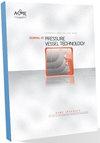缺陷宽度对含腐蚀缺陷复合修复管道爆破能力影响的有限元分析
IF 1.4
4区 工程技术
Q4 ENGINEERING, MECHANICAL
Journal of Pressure Vessel Technology-Transactions of the Asme
Pub Date : 2023-10-27
DOI:10.1115/1.4063889
引用次数: 0
摘要
摘要本文研究了缺陷宽度对纤维增强聚合物复合材料修复腐蚀管道爆破能力的影响。对含局部腐蚀缺陷和全周腐蚀缺陷的复合修复管道进行了参数化有限元分析。分析结果表明,含局部缺陷的复合修复管的爆破能力明显低于含全周缺陷的复合修复管。通过参数化有限元分析,发现基于ASME PCC-2规范中推荐的设计方程导出的爆裂能力模型对于局部缺陷复合修复管道具有非保守性。然后建立了缺陷宽度修正因子的经验方程,并证明该公式在提高PCC-2突发容量模型的预测精度方面非常有效。本文章由计算机程序翻译,如有差异,请以英文原文为准。
Investigation Of The Defect Width Effect On The Burst Capacity Of Composite-Repaired Pipelines With Corrosion Defects Using Finite Element Analysis
Abstract The present study investigates the effect of the defect width on the burst capacity of corroded pipelines repaired with fiber reinforced polymer composite. Parametric finite element analyses are carried out to evaluate the burst capacities of composite-repaired pipes containing localized and full-circumferential corrosion defects. The analysis results indicate that burst capacities of composite-repaired pipes containing localized defects can be markedly lower than those of composite-repaired pipes with full-circumferential defects. The burst capacity model derived from the design equation recommended in the ASME PCC-2 code is found to be non-conservative for composite-repaired pipes with localized defects based on the parametric finite element analyses. An empirical equation for the defect width correction factor is then developed and shown to be highly effective in improving the predictive accuracy of the PCC-2 burst capacity model.
求助全文
通过发布文献求助,成功后即可免费获取论文全文。
去求助
来源期刊
CiteScore
2.10
自引率
10.00%
发文量
77
审稿时长
4.2 months
期刊介绍:
The Journal of Pressure Vessel Technology is the premier publication for the highest-quality research and interpretive reports on the design, analysis, materials, fabrication, construction, inspection, operation, and failure prevention of pressure vessels, piping, pipelines, power and heating boilers, heat exchangers, reaction vessels, pumps, valves, and other pressure and temperature-bearing components, as well as the nondestructive evaluation of critical components in mechanical engineering applications. Not only does the Journal cover all topics dealing with the design and analysis of pressure vessels, piping, and components, but it also contains discussions of their related codes and standards.
Applicable pressure technology areas of interest include: Dynamic and seismic analysis; Equipment qualification; Fabrication; Welding processes and integrity; Operation of vessels and piping; Fatigue and fracture prediction; Finite and boundary element methods; Fluid-structure interaction; High pressure engineering; Elevated temperature analysis and design; Inelastic analysis; Life extension; Lifeline earthquake engineering; PVP materials and their property databases; NDE; safety and reliability; Verification and qualification of software.

 求助内容:
求助内容: 应助结果提醒方式:
应助结果提醒方式:


